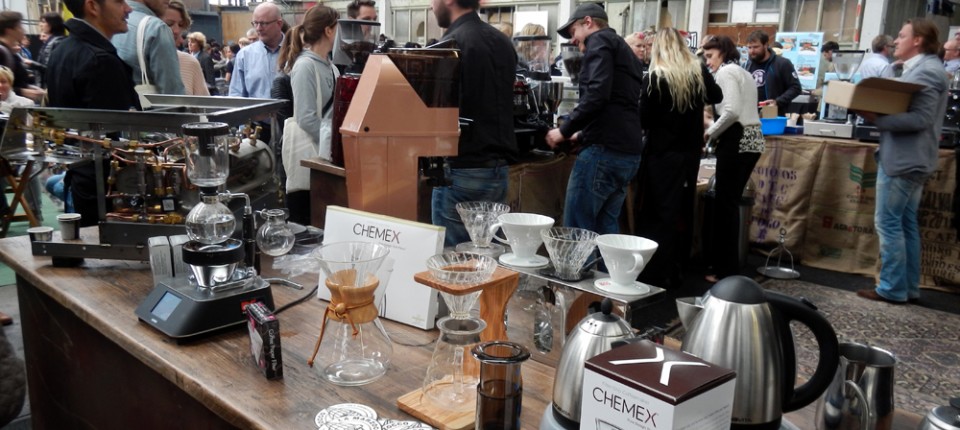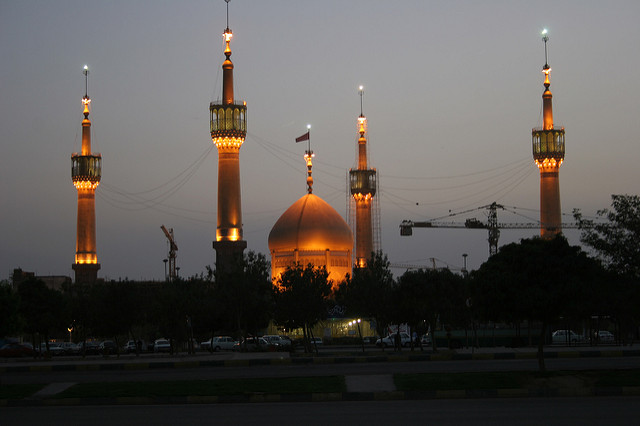In Amsterdam today, specialty coffee bars are mushrooming. Does this mean that Amsterdammers have become coffee gluttons from one day to the next? Fact is that the spread of specialty coffee bars is not confined to Amsterdam, but a phenomenon that can be observed in almost every world city, be it Vancouver, Istanbul, or Kunming. It is obvious that structural factors apply such as, firstly, the transformation of the manufacturing economy to what Alan J. Scott would label the cognitive-creative economy; secondly, the concomitant concentration in urban centres of high-skilled and on life-style and connections oriented individuals; and thirdly, the proliferation of new forms of urbanism. But how does this work in practice? Here, we examine what is actually happening in these specialty coffee bars.
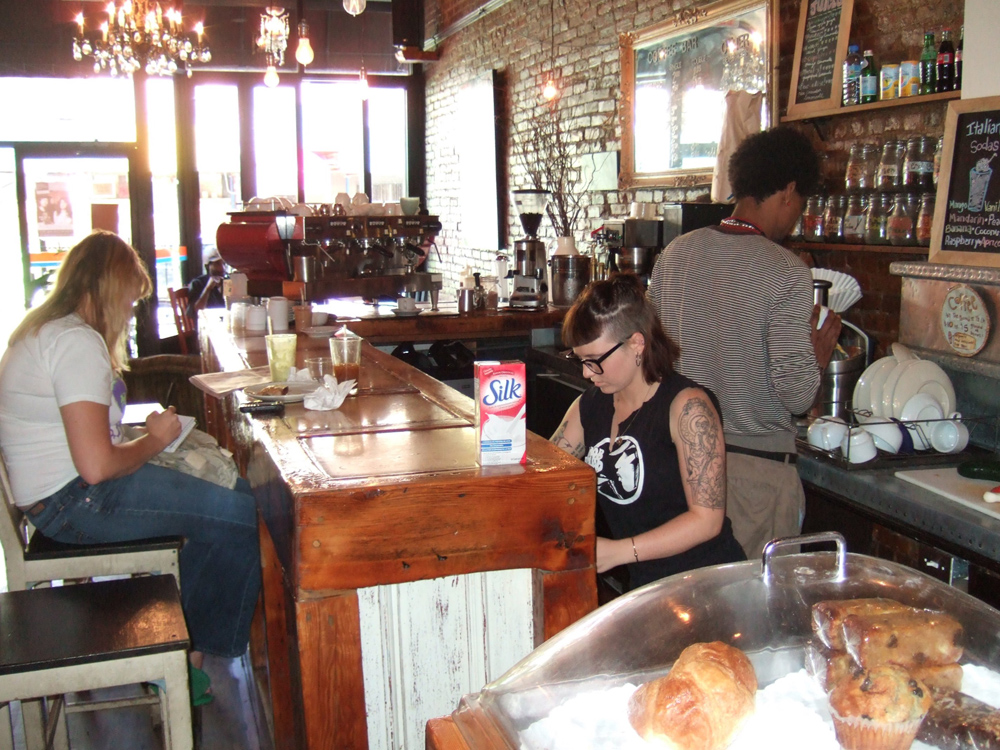
The Outpost in New York’s Bedford-Stuyvesant is one of the few establishments patronised by caucasian locals in a predominantly African-American neighbourhood, suggesting that gentrification is on the way (Photo: Jan Rath)
Older readers may still recall the typical Amsterdam ‘brown cafes’, licensed premises featuring dark wood due to years of smoking patrons. These cafes cherished a warm and cozy atmosphere by offering a drink, a snack, a friendly conversation, and a game of cards or billiards. Coffee was available any time of the day. Indeed, a pot of lukewarm and often stale coffee was patiently waiting on a warming plate. Next to brown cafes, there were ‘coffee shops’ (koffiehuizen) — not to be confused with establishments for the sale of cannabis for personal consumption. Most of the time, these were non-licensed, casual eating and drinking places with Formica tables and chequered serviettes. Koffiehuizen served coffee, tea or milk, and also light lunches such as cheese rolls, omelets, and croquets. Here too, patrons enjoyed their coffee in white china cups while sitting at a table. To be sure, at both types of premises the range of coffee products was limited to either black coffee or coffee with milk.
How different are things on the urban coffee front today? Percolator coffee is no longer existent unless in very, very hip specialty bars where slow coffee is on the menu. Now, a cup of coffee is typically freshly brewed either by a high-end shiny, chrome espresso maker, preferably of Italian design, or a less fancy and less expensive coffee machine, but always on individual order. The introduction of these newfangled machines has been accompanied by real quality improvements, or at least the pretension thereof. These improvements responded to and paved the way for a further fragmentation of consumer preferences. Where once a simple black or white coffee was a dominant feature of cafes in most cities, the production and consumption of a whole array of caffeinated beverages have been following a pattern that is commonplace in the entire post-Fordist world.
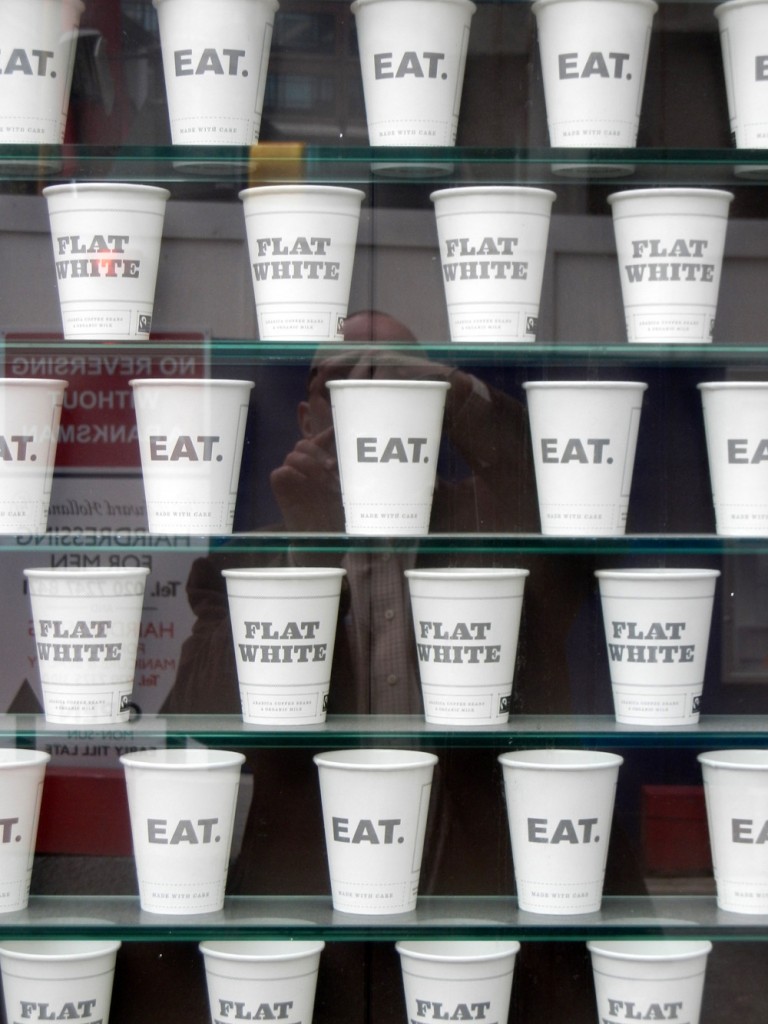
Subtle suggestions of what to consume at a hip coffee bar in London (Photo: Jan Rath)
A coffee glutton who wishes to order the brown gold starts an extensive conversation full of implicit and explicit choices and oftentimes using real or alleged Italian or American idiom. Is the coffee ‘for here’ or ‘to go’, because it is no longer self-evident to get the caffeine intake while sitting at a table? What size do you want? 12 or 16 oz., a ‘tall’, ‘grande’, or ‘venti’, or a ‘small’, ‘medium’, or ‘large’? Do you care for an extra espresso shot? What shall it be? A ‘ristretto’, ‘cappuccino’, ‘macchiato’ or ‘latte’? What milk do you take? ‘Whole milk’, ‘2% reduced-fat milk’, ‘skimmed milk’, or perhaps ‘soy milk’? Do you prefer a wet or dry cappuccino? How about decaffeinated coffee? Those with a sweet tooth may fancy a bit of syrup with vanilla, hazelnut, or orange taste.
True coffee lovers turn up their nose of such dilutions, of course, and consciously opt for an exquisite ‘doppio’ made of the distinctive beans of the Zambia Peaberry Terranova Estate, Organic Ethiopia Sidamo, or the Jamaica Blue Mountain Nr. 2. In so doing, the patron does not only experience a banquet of the senses but also enters a hitherto unknown but exciting brave new world. And there is more. On a lucky day, the waiter… oh, we’re sorry, the barista, may indulge him- or herself in an explosion of creativity in the form of latte art. Ordering a cuppa then suddenly becomes an exciting artistic exercise! What’s more: going for a coffee offers gluttons the opportunity to publicly display their connoisseurship and to distinguish themselves from others.
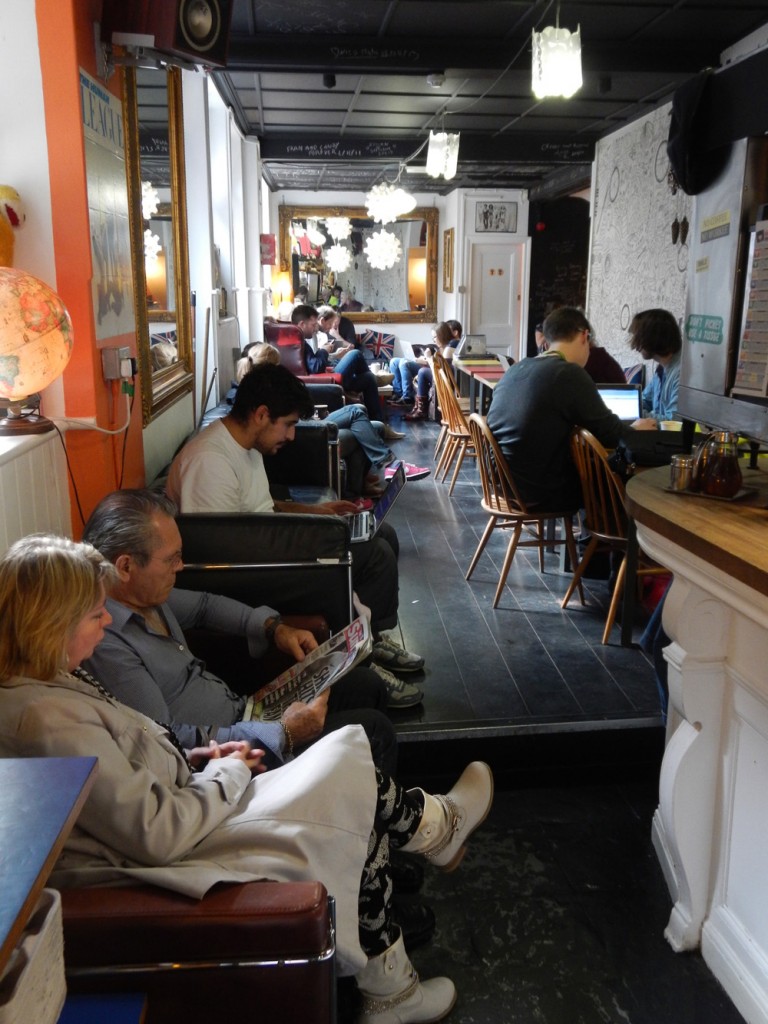
Coffee bar on London’s Brick Lane, a rapidly gentrifying district (Photo: Jan Rath)
Most if not all cafes have gone with the flow and offer customized coffee, but this not seldom boils down to an uninspired and cold-heartedly produced brew with washed-out foam, recalling dishwater. Much more interesting—and tastier—are the specialty coffee bars that sprout up in almost every corner of the city. On the one hand, there are the coffee bars that are part of larger national or international chains such as Buongiorno Espressobar, Bagels & Beans, the Coffee Company, or Starbucks. Each represents its own brand and claims exclusivity, but at the end of the day, they deliver a pricy, ready-to-drink cup. On the other hand, there are numerous one-off operations: independent coffee bars often owned and managed by young hipsters. Quite a few have been decorated with make-shift furniture, such as tables made of used doors or other ‘authentic’ raw materials, while the chalk layers have been carefully chipped off the wall, making the power lines, water pipes and the upstairs neighbor’s sewer visible. On the counter, one usually finds an assortment of muffins, brownies and other (organic) foodstuffs. Some coffee bars mix the sales of coffee with other products, such as design clothing (e.g., Koko Design & Coffee) or hair dressing (e.g., Cut Throat Barber & Coffee).
Together they are part and parcel of an expanding sector of the economy that is driven by a high level of professionalization: there are branch associations such as the Specialty Coffee Association of Europe (SCAE) promoting the sector and its products, websites and glossy magazines, coffee bar guides, barista training programs (in some cases offered by a Coffee Academy or at a coffee boot camp), coffee making and latte art contests, and even international coffee festivals. Such a sector with such premises and products are clearly established by and for a particular type of urbanites: students, urban professionals, and cool creative types who are continuously online and connected to the rest of the world. All seem to be involved in what the urban sociologist Manuel Castells would call, the ‘space of flows’.
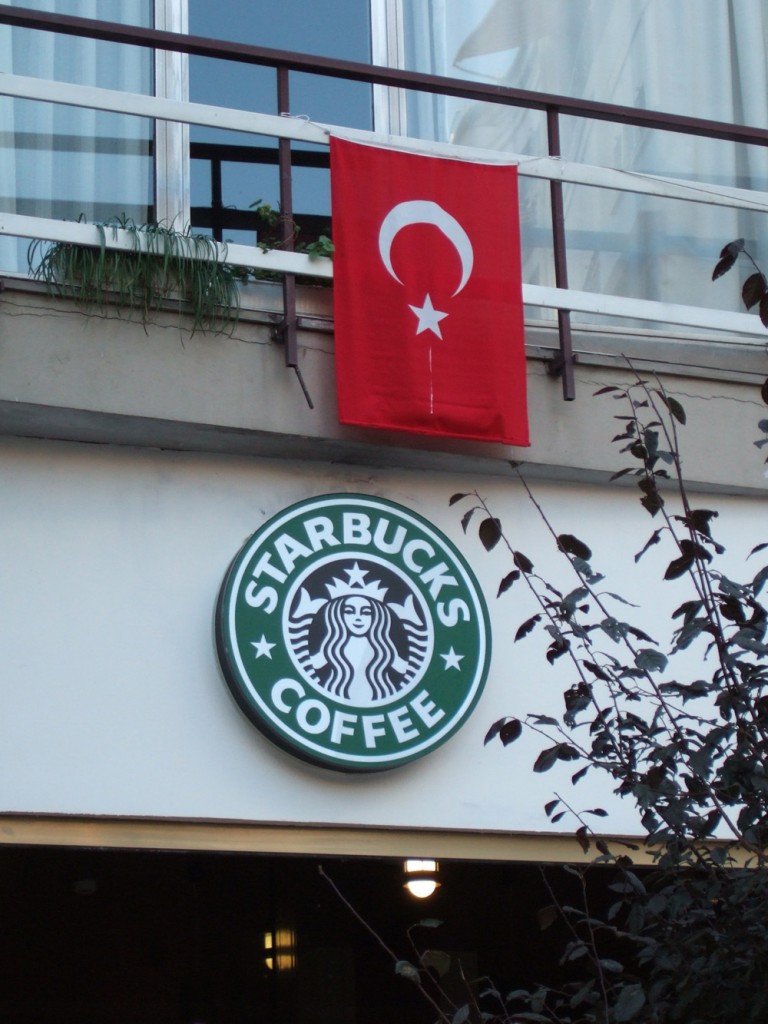
Starbucks goes globalised in Istanbul’s Moda neighbourhood (Photo: Jan Rath)
But how do people act in such public spaces? The famous sociologist Erving Goffman described and analyzed human Behavior in Public Places (1963) and he emphasized the impact of such structural conditions as anonymity and hectic. He observed that many individuals actually claim the right to maneuver in public space without being noticed or bothered by others. People are obviously aware of others, but refrain from imposing themselves on them. If applied to specialty coffee bars, it could then be argued that patrons would stay aloof of each other. They would appreciate the other’s privatized space and avoid conversation or even eye contact. Goffman coined the term civil inattention to describe such polite, civilized and standoffish behavior.
But does this really describe what is happening in coffee bars? For a number of years already, Starbucks has marketed itself as: ‘A place for conversation and a sense of community. A third place between work and home.’ The coffee multinational has borrowed the concept of the third place from the urban sociologist Ray Oldenburg. In his seminal book The Great Good Place ([1989]1999: 16), Oldenburg introduced the third place ‘as a generic designation for a great variety of public places that host the regular, voluntary, informal, and happily anticipated gatherings of individuals beyond the realms of home and work’. Third places, he argued, serve as levelers; they are inclusive and open to all social classes, genders, and so forth. The main activity within third places is conversation, allowing for camaraderie of sorts. Third places provide a sense of ‘at-homeness’. If Oldenburg would be right, specialty coffee bars would constitute a haven of sociability in an otherwise anonymous urban environment.

Demonstration of making filtered coffee at the Amsterdam Coffee Festival (Photo: Jan Rath)
Whether specialty coffee bars constitute a site for civil inattention or — quite the contrary — sociability was further explored by 84 sociology students from the University of Amsterdam. In total, 42 Amsterdam-based specialty coffee bars — ranging from chains such as Bagels & Beans and Coffee Company to independent ones like Headfirst Coffee Roasters and Screaming Beans — were the object of sociological research. Through active observations, students mapped the design of the places, made inventories of who was doing what with whom, and tried to grasp the sphere of the place. Their focus was on the tangible side (e.g., interior, visitors), but most of all on the patrons’ interaction — or a lack thereof.
The observations confirmed that, in general, specialty coffee bars differ strongly from the traditional brown cafes and coffee shops. As Linn and Enzo, two sociology students, noticed in their observation at Scandinavian Embassy, one can clearly tell that the finishing of the interior and its materials is purposely imperfect. Red-brick walls and vintage art contribute to the creation of a trendy and comfortable — potentially exclusive — sense of homeness. Such a setting recalls what the American sociologist Sharon Zukin in her book Naked City (2011) described as ‘authentic’, a form and style that appeal in particular to young, middle-class urbanites.

A piece of coffee ‘art’ at the Amsterdam Coffee Festival (Photo: Jan Rath)
In contrast to what Starbucks claimed in its optimistic and perhaps nostalgic marketing, Ray Oldenburg’s notions of a third place does not really apply. Many patrons, admittedly, do interact with others, but those interactions are mainly confined to the friends, colleagues, classmates, and business partners with whom they entered the coffee bar. And even then, many frequently retreat from these conversations to enter the virtual world: cell phones and tablets are always within reach and are used intensely. In fact, a common practice in specialty coffee bars is to fiddle with such electronic gizmos, check e-mail, write texts, read the latest, and keep abreast of whatever is hot in the world outside of the specialty bar.
Whether it is because their companions or mobile phones eat up all of their attention, patrons hardly interact with strangers. But don’t be fooled: as Ajushi and Hester found in their observation of a Coffee Company outlet downtown: patrons are aware of one another, but they choose not to get in contact with each other or even acknowledge each other’s presence. This is precisely what Erving Goffman had in mind when he introduced the concept of civil inattention.
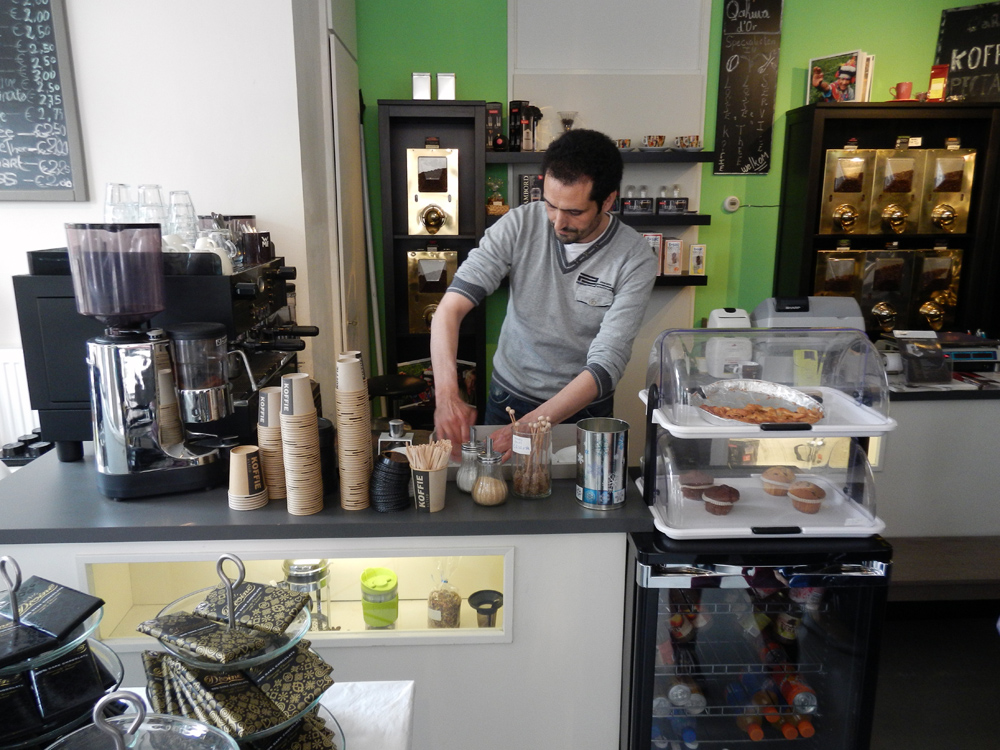
Kahva d’Or, in Amsterdam’s Indische Buurt, is a rare case of an immigrant entrepreneur making inroads into the coffee bar market in Amsterdam (Photo: Jan Rath)
Should we then conclude that the concept of the third place is to be consigned to the dustbin of urban sociology? We do not think so, if only because some bars and cafes do function as third places; some of the still existing brown cafes are cases in point. But it is important to further explore this issue. As has been indicated, many patrons are comfortably connected with others, albeit not physically and not on site. Some, such as Jeroen Beekmans and Joop de Boer of Pop-Up City, even refer to them as ‘wifi hunting urban nomads’, although it remains to be seen whether they are really nomads, as place does seem to matter.
We need a new theory and a new concept to capture the activities of a heterolocal community that does not exist in but comes alive through these specialty coffee bars. A fourth place perhaps?

